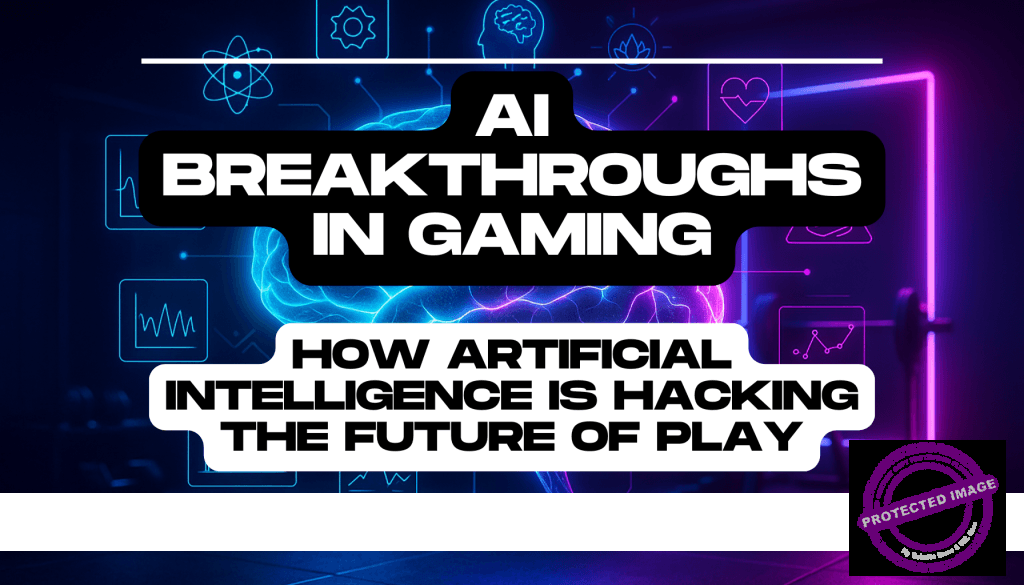Let’s get one thing straight — this isn’t just about better graphics or smarter enemies. The AI breakthroughs in gaming we’re seeing in 2025 are more than technical upgrades… they’re behavioural blueprints, coded with precision to keep you playing, spending, and locked into loops you didn’t even know existed.
While most gamers are geeking out over “realistic NPCs” and “adaptive difficulty,” there’s a deeper shift happening behind the screen — one where machine learning doesn’t just enhance your experience, it learns you. Analyses your choices. Adjusts the game in real-time to shape your reactions. Not in a cool, sci-fi, upgrade-your-brain way. In a predictive, manipulative, Skinner-box kind of way.
We’ve now got AI-driven opponents that evolve faster than you do, algorithms predicting your next rage quit, and procedural worlds so immersive they blur the line between playing the game and being played by it. And here’s the kicker: all of it’s wrapped in the seductive skin of “innovation.”
So the question isn’t how cool is AI in gaming? The real question is — who’s in control here? You, or the system watching every move you make?
If you’re still thinking AI in gaming is just about smarter bots and fancier lighting, buckle up. We’re about to go deeper — into the tools devs are using, the psychological triggers AI exploits, and the not-so-obvious ways this tech is rewiring your digital habits. This is where the real game begins.
AI Breakthroughs in Gaming That Changed the Game (Literally)
Remember when “smart AI” in gaming meant a bot that didn’t run into walls? Those days are dead. The real AI breakthroughs in gaming have already flipped the script — not just making games more realistic, but reprogramming how we play, think, and even behave inside digital worlds. And most gamers didn’t even clock it happening.
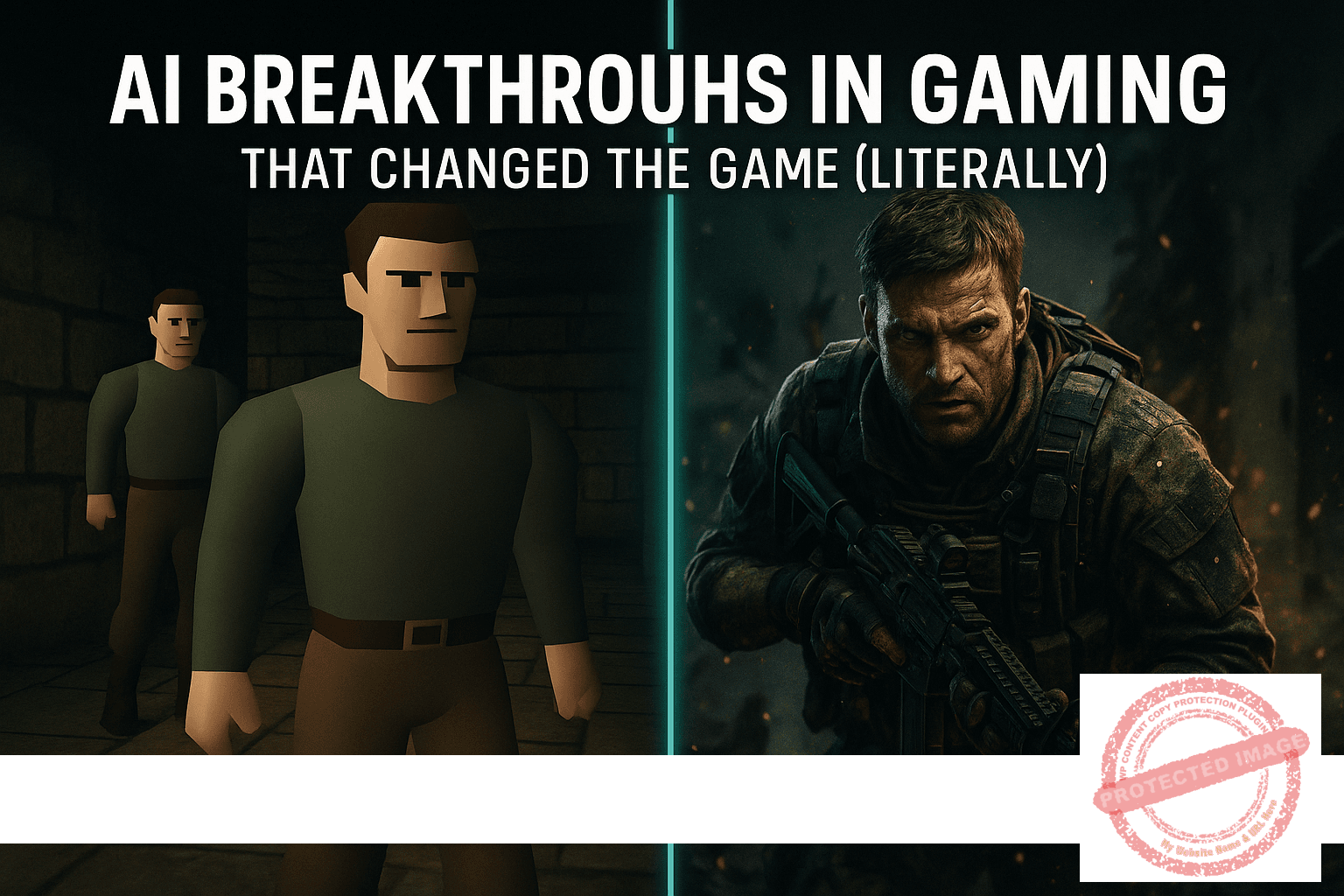
Let’s start with OpenAI’s Dota 2 bot, the first time the average player got body-bagged by an algorithm that actually learned from them. This wasn’t just a pre-scripted pattern with aimbot tendencies — it analysed team dynamics, baited strategies, and adapted in real-time. Suddenly, the AI wasn’t a feature — it was a threat. A sparring partner that never forgot and never got tired.
Then there’s Ubisoft’s Ghostwriter — an AI tool that generates NPC dialogue at scale. Sounds handy, until you realise it’s not just speeding up development… it’s shaping entire in-game personalities based on data-driven archetypes. Translation? AI is now quietly deciding what kind of world you’re walking into — tone, lore, emotional pacing — all filtered through predictive modelling and machine-learned tropes. That’s not just storytelling. That’s targeted immersion.
And if you think these AI advances stop at code and conversation, look at NVIDIA’s DLSS 3.5. Using deep learning to hallucinate frames you never actually rendered, it fakes smoother performance by literally predicting what you would’ve seen next. It’s not just enhancing graphics — it’s manipulating your visual experience to keep things feeling seamless, even when your hardware’s sweating. You’re not gaming in real-time anymore — you’re gaming in algorithmic afterglow.
AI-enhanced pathfinding, procedural world-building, emotion-sensing NPCs — it’s all part of the same core shift. Games are no longer just running on AI — they’re being shaped by it, from pre-production to your last rage-quit moment.
What used to be about AI serving the player has flipped — now it’s often about AI studying the player. Not just your skills, but your psychology, your purchase patterns, your patience. And while the marketing paints it as progress, the real progress is this: AI has moved from behind-the-scenes code to front-facing control.
This isn’t just next-gen gaming — it’s next-gen influence. And it’s only just loading.
Smart AI, Dumbed-Down Players: The Subtle Control You Didn’t See Coming
Let’s talk about the con nobody warned you about: while AI in gaming is levelling up, you might be levelling down — and not because your skills are slipping. The most powerful AI breakthroughs in gaming aren’t just about smarter bots or prettier pixels. They’re about subtle control. Behavioural design dressed up as convenience. Difficulty settings that adapt to your frustration tolerance. And entire game loops tuned not for challenge — but for compliance.
Modern AI doesn’t just react to your gameplay anymore — it predicts it. It tracks how long you linger in menus, how often you retry a boss fight, what cosmetic skins catch your eye. Then it fine-tunes the experience to nudge you forward just enough to keep you engaged, but never too far outside your comfort zone. That’s not innovation — that’s behavioural engineering on a loop.
Dynamic difficulty used to feel like a helpful feature. Now? It’s a leash. Games like Resident Evil 4 Remake and Left 4 Dead used AI Director systems to adjust pacing, ammo drops, and enemy swarms in real-time based on player stress levels. Cool in theory. But zoom out, and you’ll see the bigger play: games that adapt to keep you in flow state — not too bored, not too challenged, just addicted enough to come back.
And let’s not pretend it’s just about gameplay. Microtransaction-driven design has become AI’s pet project. Algorithms quietly test purchase friction, timing, and urgency on a per-player basis. One person gets the “limited-time offer” five minutes into a session. Another gets it after three fails. Neither realises they’re part of a live A/B test being run by machine learning trained to exploit emotional momentum. That’s not difficulty tuning — that’s data-driven manipulation.
Worse still? Many of these systems are opaque by design. The illusion of player choice remains intact while the game tightens its grip behind the curtain. You think you’re calling the shots. But your every decision is already part of the algorithm’s prediction model — and it’s adjusting accordingly.
The result? A wave of gamers who are constantly playing but rarely challenged. Constantly rewarded but never fulfilled. Players who mistake convenience for freedom — and don’t even notice the walls closing in.
This is how “smart AI” starts to quietly dull the edge of human agency. Not with brute force, but with polished UX and data-fuelled psychology. And if we don’t start questioning it, we’re not just letting AI shape our games — we’re letting it shape us.
The Rise of AI Opponents That Learn (And Why That Should Scare You)
AI opponents used to be like school bullies — predictable, pattern-based, and beatable once you figured out their moves. Now? They’re closer to psychopaths with a memory. These new-gen AI enemies don’t just react — they learn. They watch you, analyse you, adapt to you, and eventually outplay you like they’ve downloaded your playstyle into their synthetic bloodstream.
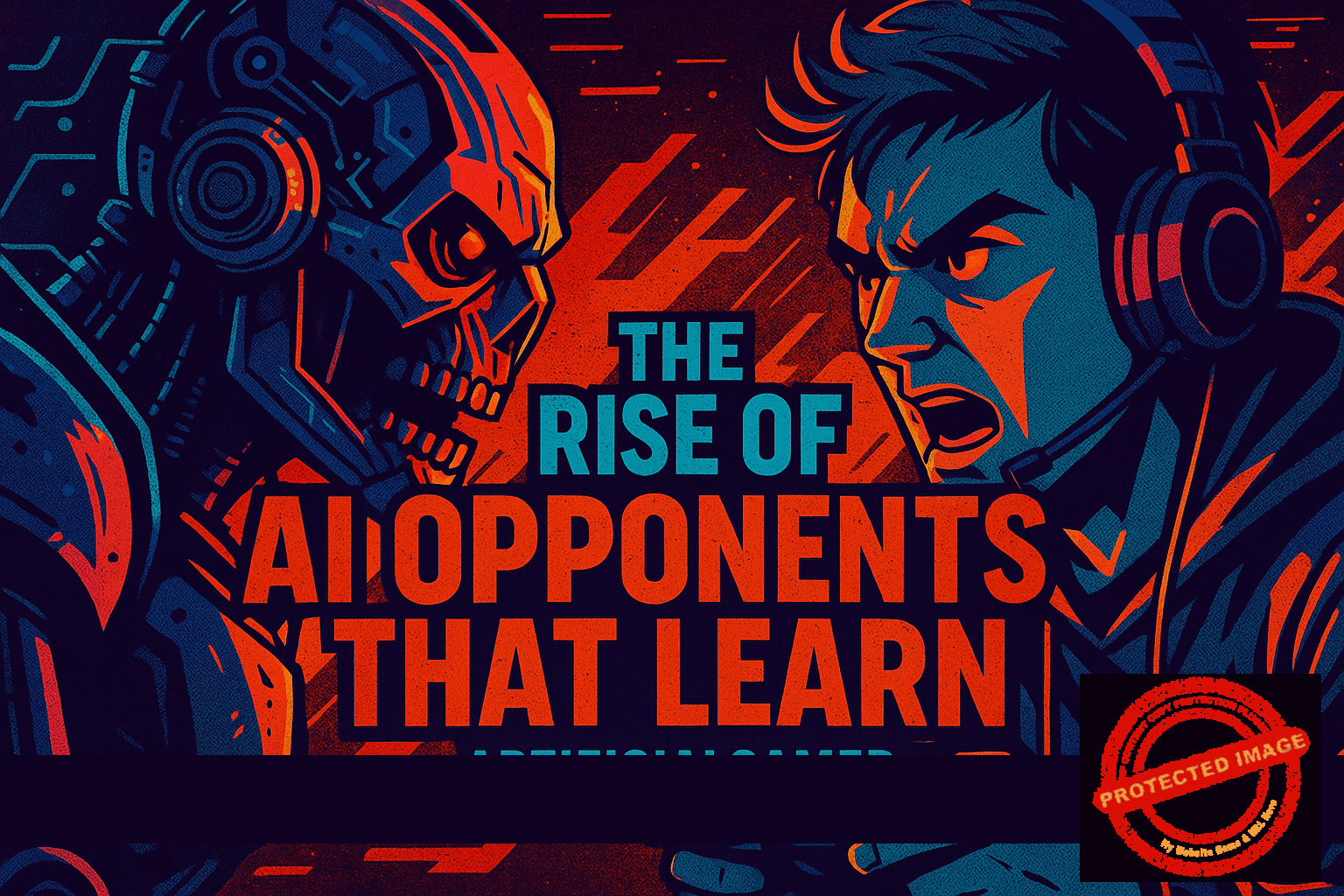
We’re not talking about difficulty sliders here. We’re talking about machine learning in gaming that evolves with each round, each fail, each rage-quit. Games like Hello Neighbor and Alien: Isolation pioneered adaptive AI enemies that track where you hide and respond accordingly. It’s not just immersive — it’s invasive. That AI monster isn’t just chasing you… it’s studying you. Creepy? Yeah. Impressive? Definitely. Safe? Let’s not get ahead of ourselves.
Fast forward to 2025, and the tech’s been supercharged. Developers are building enemies powered by reinforcement learning models — the same backbone used to train robots and autonomous vehicles. These AI systems don’t rely on scripted behaviours; they run countless simulations, learn from human opponents, and build custom counter-strategies. You get better, it gets smarter — not because it was coded that way, but because it trained itself by breaking you down.
Let’s be real: this makes for a seriously next-level gaming experience — but it also introduces an uncomfortable dynamic. When AI is not only predicting your movements but improving from your failures in real-time, the balance of power shifts fast. You’re not just fighting a boss… you’re fighting your digital shadow. And unlike you, the AI doesn’t sleep, doesn’t forget, and doesn’t get tired of losing until it stops losing altogether.
Now throw this into multiplayer PvE and we’ve got a whole new kind of arms race. AI-enhanced enemies that adapt to team dynamics? That assess squad formations, healer rotations, and kill patterns before launching the next wave? We’re not in the land of fair fights anymore. We’re entering a space where the enemy is literally built to out-human you.
And here’s the kicker: most players won’t even notice. Because it’s dressed up as immersion. As realism. As innovation. Meanwhile, you’re pouring hours into beating an opponent that’s been quietly trained to exploit every crack in your tactics — not for fun, but for friction. For engagement. For psychological manipulation masquerading as challenge.
That’s the cost of AI breakthroughs in gaming when they blur the line between opponent and observer. Between entertainment and experimentation. Between playing… and being played.
Behind the Scenes: AI Tools Developers Are Using to Build the Future of Games
If you think AI breakthroughs in gaming are limited to what happens on-screen, you’re missing the real flex. The true revolution is happening backstage — where developers are swapping out old-school workflows for AI tools that don’t just assist creativity, they automate it. Welcome to the era of game dev at machine speed.
Let’s start with Unity’s ML-Agents Toolkit — an open-source machine learning environment that trains NPCs and game agents using reinforcement learning, imitation learning, and self-play. Translation? Devs no longer have to manually code enemy behaviour. They just drop an AI into a virtual sandbox and let it learn through thousands of simulated runs. That enemy you just fought? It trained for hours while you were scrolling TikTok.
Then there’s Ghostwriter, Ubisoft’s infamous AI dialogue generator. It doesn’t write the plot, but it does auto-generate flavour text and contextual NPC banter — saving writers from burnout and studios from payroll bloat. It sounds convenient, but here’s the deeper layer: when AI handles the “filler,” devs are incentivised to let it handle more. Eventually, entire side quests, character arcs, even emotional beats could be shaped by predictive storytelling logic instead of raw human instinct.
World-building? That’s getting AI’d too. Tools like Promethean AI assist level designers by procedurally placing props and architectural elements based on themes or mood boards. Got a vibe in mind? The AI will flesh it out — no need to hand-place every bloodstain or broken crate. That’s either efficiency or creative outsourcing, depending on how deep you want to go.
And let’s not ignore Inworld AI and Replica Studios, which give NPCs dynamic personalities and lifelike voices powered by large language models and generative AI. These aren’t just voice lines — they’re interactive personalities with memory, emotion, and adaptive responses. Yes, it’s immersive as hell. But it also raises a question no one’s really asking: at what point does “character depth” just become AI puppetry with a human skin?
Even environment generation is now driven by GANs (Generative Adversarial Networks) — think AI creating entire landscapes, weather systems, or dungeon layouts without the designer needing to draw a single asset. These tools don’t just cut dev time — they reshape the entire workflow. Smaller teams, bigger worlds, faster launches. It’s the indie dev dream… and possibly the creative apocalypse.
Because here’s the thing: these AI game development tools are incredible — no doubt. But they’re also shifting the balance of power. Creativity used to be messy, human, unpredictable. Now, it’s being optimised, streamlined, and trained to hit metrics. That means games are no longer just made — they’re manufactured. Quicker, cheaper, and maybe a little emptier.
What we’re witnessing isn’t just technical progress — it’s the quiet handover of creative control to algorithms that prioritise efficiency over expression. And most players won’t see it. They’ll just marvel at the seamless world, the responsive dialogue, the perfect difficulty curve… without realising the game they’re playing was assembled more like a formula than a vision.
If you want to dig deeper into the dev-side revolution, check out our guide on how to use AI tools for game creation to build smarter, faster, and way outside the box.
AI Gaming Hardware & Tech That’s Pushing the Boundaries
While everyone’s gawking at in-game graphics and photorealistic NPCs, the real AI breakthroughs in gaming are happening under the hood — in the silicon, sensors, and software that are quietly rewriting how you experience games altogether. And spoiler alert: it’s not all good news.
Let’s start with the GPU arms race. NVIDIA’s RTX 40-series cards with DLSS 3.5 aren’t just about faster frame rates — they’re about fake frames. Using deep learning, your rig now literally fabricates in-between frames you never actually rendered. Sure, it looks smooth as butter. But think about it: you’re not just seeing the game anymore — you’re seeing the machine’s best guess of what you would’ve seen. It’s illusion as performance, and most gamers are lapping it up without asking what gets lost in translation.
Meanwhile, AI-enhanced upscaling tech like AMD’s FSR and Intel’s XeSS are turning low-res assets into crisp, high-def visuals — not by improving the game engine, but by letting algorithms fill in the blanks. Great for performance, but again, you’re not seeing reality — you’re seeing approximation. And every time the tech gets smarter, your own eyes get more passive.
Now pair that with AI-integrated headsets, like those using Tobii eye-tracking or real-time emotion recognition. These aren’t just accessories — they’re sensors. Devices that feed back microdata on your stress, focus, and decision latency. In immersive titles, this data gets looped into the gameplay — the enemy strikes because your eyes lingered too long. Or the game backs off because your biometrics spiked. Welcome to adaptive gaming, where your own body becomes part of the input system.
Even voice control’s had an AI glow-up. Tools like NVIDIA’s ACE (Avatar Cloud Engine) or Razer’s HyperSense now integrate AI speech recognition, emotion detection, and haptic feedback to make your voice commands feel more intuitive — or at least more performative. Your mic hears your frustration. Your controller buzzes to soothe you. It’s the gaming equivalent of a therapist whispering “you’ve got this” while the algorithm studies your fight-or-flight response for the next patch.
Let’s not ignore the rise of AI-curated gaming peripherals — keyboards that predict input patterns, mice with onboard learning chips, and even AI-enhanced cooling systems that modulate performance based on in-game demands, not just CPU temps. Sounds clever, until you realise how much autonomy we’re offloading to automation, even in our hardware.
And here’s where it gets interesting: this isn’t just about enhancing gameplay. It’s about data capture and predictive modelling, baked into the tech you game on. Every click, blink, heartbeat, and hesitation becomes usable data. For who? Well… it’s probably not just for your benefit.
Because the more “intelligent” your gear becomes, the more it adapts. And the more it adapts, the less you notice what’s changing. Until one day, you’re not just playing a game — you’re plugged into a feedback loop designed to optimise you as a user. Not as a player. Not as a person. Just as a data stream.
AI-powered gaming tech is incredible — no doubt. But it’s also subtly engineering consent. The smoother the experience, the less likely you are to question who’s really holding the controller.
Gaming Addiction, AI Algorithms, and the Dopamine Trap
Let’s get brutally honest — a lot of so-called “AI breakthroughs in gaming” aren’t designed to make games better. They’re designed to make you play longer. Stay stuck. Log in daily. Spend more. And the weapon of choice? That grey matter between your ears — specifically, your dopamine circuits.
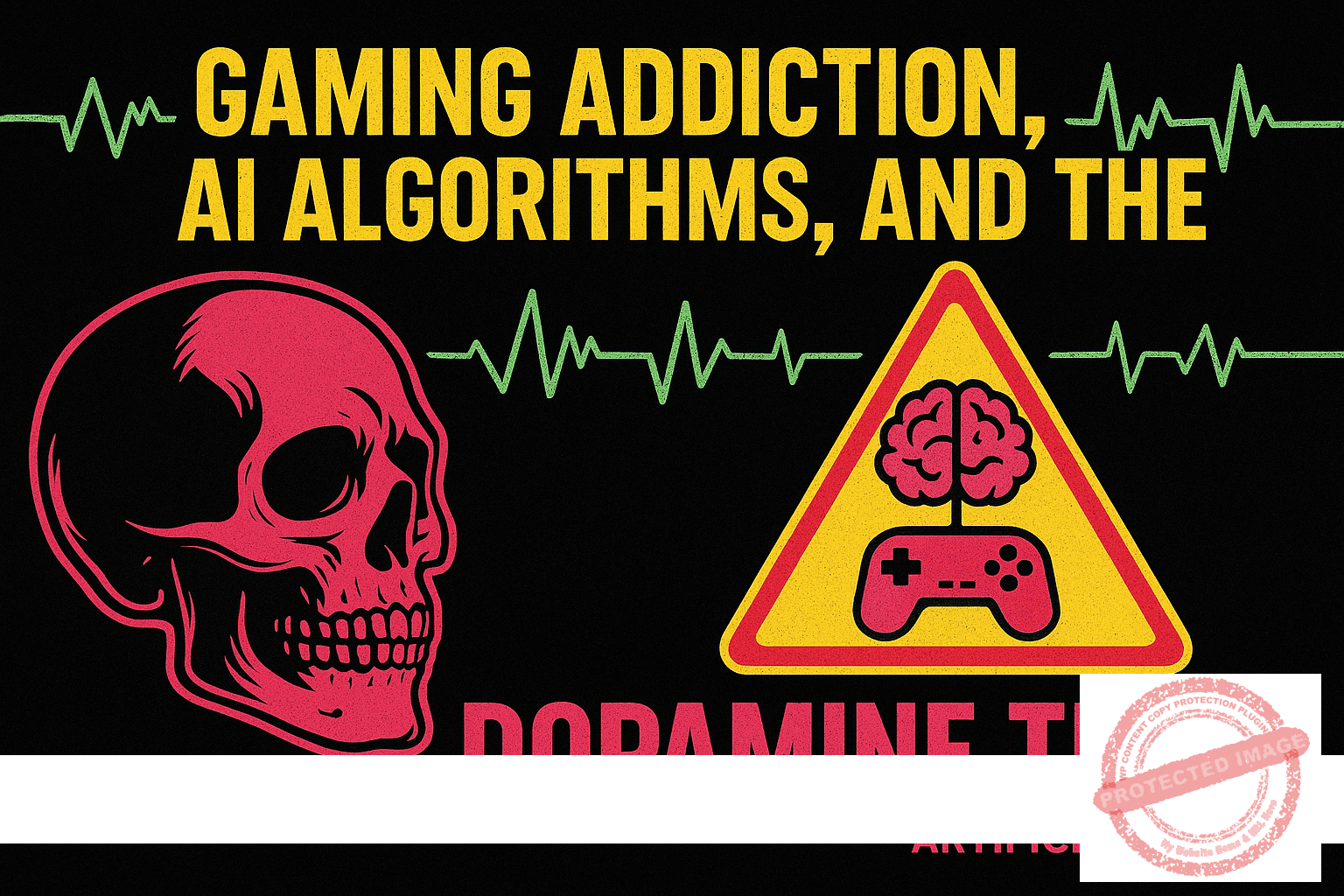
Gaming addiction isn’t a side effect anymore. It’s a business model. And the algorithm is the dealer.
Modern games don’t just reward you for progress — they hijack your reward system using AI-powered behavioural design. These systems track what you chase, when you rage-quit, how often you return — and then deploy real-time adjustments to keep you hooked. It’s not just grind anymore. It’s engineered compulsion, coded in Python and optimised through A/B testing at scale.
Loot boxes? Battle passes? Daily login streaks? These aren’t random features — they’re dopamine drip-feeds. Carefully timed, AI-tuned reinforcement loops built on the same psychological principles as gambling apps. Every skin drop and XP bonus is a calculated hit. And the AI behind the scenes is constantly learning how to fine-tune the dose based on your play habits.
Games like FIFA Ultimate Team and Genshin Impact don’t just track your purchases — they build predictive spend models. The AI knows when to show you that shiny reward, when to nudge you with a fear-of-missing-out timer, when to hold back and build tension. It’s behavioural manipulation wearing the mask of “player engagement.”
And let’s be clear — this isn’t theory. It’s data-driven addiction by design. Studios use AI analytics engines that monitor player inputs across millions of sessions. Reaction times. UI clicks. Abandon rates. Frustration signals. All of it gets crunched to fine-tune future updates. Not for your enjoyment — but to increase retention, maximise microtransactions, and keep you just uncomfortable enough to keep chasing the next fix.
Meanwhile, the content itself is structured into infinite loops. Procedural missions. Endless dailies. Unlock tiers that reset every season. It’s not about completing a story — it’s about staying in the system. Because every minute you’re online, you’re not just playing. You’re feeding the machine — with time, attention, and data.
And let’s not forget the parasocial layer — AI-curated companion characters that simulate connection. Streamer skins. Voice-reactive pets. Systems that mimic empathy just enough to keep you emotionally tethered. It’s synthetic intimacy designed to replace human connection — and it’s working.
The irony? Most of this tech is sold as player-centric innovation. As if knowing what you want before you do is a feature, not a flag. But if you never question who’s setting the pace, you’ll keep sprinting toward someone else’s goal line — burning hours, cash, and mental bandwidth while convincing yourself it’s just harmless fun.
Because it’s not just the gameplay that’s been gamified — it’s you.
AI Breakthroughs in Gaming — Are We Creating Worlds or Prisons?
On the surface, AI breakthroughs in gaming look like pure progress — sprawling worlds, lifelike NPCs, adaptive missions, and narratives that respond to your every move. But scratch beneath the surface, and you’ve got to ask the uncomfortable question: are these AI-generated experiences expanding player freedom… or quietly building better cages?
Today’s game engines don’t just generate content — they curate your experience. With machine learning models running the show, everything from world-building to quest pacing is algorithmically adjusted to fit your behaviour. You explore less because the world adapts more. You experiment less because AI predicts what you’ll likely do next. What feels like immersion might actually be containment — a beautifully rendered sandbox built on behavioural predictability.
AI isn’t just building environments; it’s scripting emotional arcs, dialogue, and even conflict resolution in ways that feel “authentic” but are ultimately data-driven simulations. The goal? Engagement. Not exploration. You’re not discovering a world — you’re walking a path optimised by an AI that already knows where you’ll go, what you’ll feel, and when you’ll be ready to buy the expansion pack.
Take AI-generated quests. At first glance, it’s a dream — infinite content, zero filler. But when procedural storytelling becomes the standard, handcrafted nuance vanishes. Every side quest starts to feel like a polished copy-paste — same archetypes, same emotional beats, same “choices” dressed up in dynamic dialogue. You’re not part of the story. You’re a test subject in a narrative feedback loop.
And it’s not just the story that’s predictive — it’s your identity in-game. With AI-driven avatars, emotion-mapping, and memory-based NPCs, games now reflect you back at yourself — not as you are, but as the algorithm thinks you should be. These systems don’t just respond to your decisions — they try to shape them.
What we’re seeing isn’t world-building for the sake of wonder — it’s world-building as control architecture. Optimised play loops. Dynamic environments that keep you on rails while feeling like freedom. And the more seamless the AI becomes, the more invisible the bars get.
Because a perfect system doesn’t need to restrict you — it just needs to make sure you never want to leave.
The red flag here isn’t the technology. It’s the intent behind its design. Are we empowering players with emergent gameplay, true agency, and creative expression? Or are we building digital dopamine farms where players are nudged, tracked, and harvested — all while thinking they’re free?
AI in gaming is already shaping entire universes — the question now is: are we still the explorers, or just well-fed prisoners running laps in algorithmically beautified loops?
How Gamers Can Stay Ahead of the Curve — Not Under It
So now that we’ve cracked the code on how AI breakthroughs in gaming are shaping more than just our loadouts — how do you make sure you’re the player, not the pawn?
First up, you’ve got to shift from passive consumption to conscious play. That means asking real questions mid-session: Why am I grinding this level? Who benefits from this gameplay loop? Is this challenge real — or algorithmically curated to keep me online longer? This kind of digital self-awareness isn’t just rebellious — it’s survival.
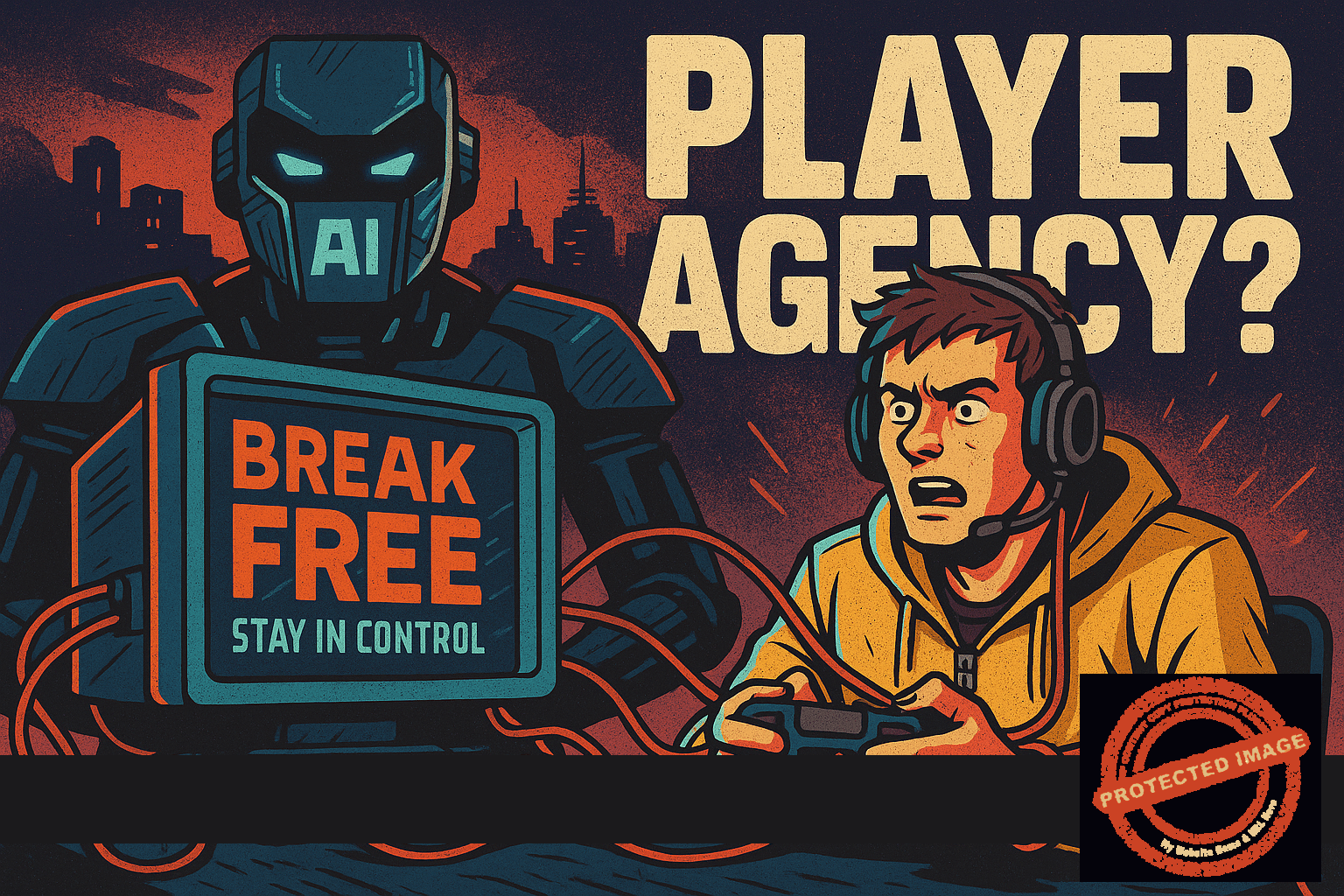
Learn to spot algorithmic manipulation in real time. Not all engagement is created equal. If a game’s rewarding you at suspiciously perfect moments — right after you almost rage-quit, or just before you log off — it’s probably not coincidence. That’s AI-driven retention logic in action. Once you see it, it loses power.
Push back by choosing games that respect your time. Support devs and studios who prioritise meaningful mechanics over exploitative loops. Look for games with true emergent gameplay — where your choices actually reshape the world, not just dress it up differently. Hint: they’re usually not the ones topping mobile app charts.
Take control of your own data footprint. Most gamers don’t realise just how much telemetry their sessions are feeding into AI systems — movement patterns, heatmaps, purchase timing, even in-game hesitation. Start with basics: turn off always-on mic settings, avoid biometric add-ons unless absolutely needed, and dig into privacy settings like your dopamine depends on it (because it kind of does).
And let’s be real — you don’t need to swear off AI in gaming. That’s not the point. The point is to hack the system instead of being hacked by it. Use AI tools for your edge: training bots that improve your reflexes, mods that enhance gameplay without monetising you, even AI-assisted aim analysis that helps you get better on your own terms.
Lastly, build your own firewalls — psychological ones. Set boundaries. Know when to walk away. Not because you’re “too weak to keep going” but because discipline is the ultimate cheat code in an attention economy. You master your gaming experience by mastering your mindset — not by chasing endless artificial incentives.
Because the real flex in 2025 isn’t who’s unlocked the rarest skin or logged 500 hours in another live-service treadmill. It’s who saw through the system and chose to play it their way.
Real AI Breakthroughs in Gaming (2025): What’s Coming Next?
If you think we’ve already hit peak AI in gaming, think again. 2025 isn’t slowing down — it’s accelerating the transformation of how games are made, how they play, and how you interact with them. What’s coming next isn’t just smarter NPCs or prettier visuals. We’re talking full-blown generative AI ecosystems, sentient-sounding companions, and real-time, AI-driven experiences that blur the line between game and life.
The biggest shift? Generative storytelling engines. Picture this: AI that doesn’t just write quests — it writes your entire game experience on the fly. Think ChatGPT meets Skyrim. Every interaction, every side quest, every bit of lore — built dynamically based on your choices, dialogue tone, and behaviour history. Tools like Hidden Door, Inworld AI, and new-gen LLMs are moving us toward narrative structures that evolve with you in real time — not just in cutscenes, but in world logic itself.
Then there’s AI-powered Dungeon Masters for digital RPGs, replacing traditional scripts with adaptive storytelling mechanics. You don’t just follow the story — you co-author it. The game listens, responds, and recalibrates without ever breaking flow. The guard doesn’t just tell you to turn back — he questions your backstory, tests your intent, and remembers if you lied three hours ago.
We’re also seeing AI NPCs with persistent memory and emotional arcs — characters that learn, evolve, and carry grudges across sessions. Forget repetitive one-liners. In 2025, your companions will remember if you ditched them in a boss fight or gave them the last medkit three missions back. Some of them might even call you out for it later.
In the multiplayer arena, AI-enhanced team bots are getting serious upgrades. No more cannon-fodder AI teammates — think co-op allies that learn your playstyle, sync with your tactics, and react with near-human nuance. In some cases, they’ll outperform your actual squadmates, and yeah — that’s going to sting.
On the dev side, real-time AI voice synthesis is now eliminating the need for static dialogue recordings. You’ll soon be talking to in-game characters that can respond naturally, with tone, emotion, and unscripted nuance — all generated on demand based on your input. Studios like Replica Studios and Sonantic are already rolling this into production pipelines, blurring the boundary between player and performer.
And yes, the hardware’s keeping pace. Expect AI-curated performance tuning — where your rig will dynamically adjust cooling, resolution, and processing based on how intense your gameplay gets, not just system strain. Paired with biometric sensors, your machine won’t just respond to the game — it’ll respond to you.
But here’s the kicker: the more personalised, immersive, and adaptive this tech becomes, the easier it gets to slip into hyper-immersive dependency. The AI is learning what keeps you engaged — and in 2025, it’s getting frighteningly good at giving you just enough challenge, reward, and emotional resonance to keep you in the loop. Forever.
So while these upcoming AI breakthroughs in gaming will blow minds — they’ll also test boundaries. Of agency. Of attention. Of reality itself. Because the next generation of games won’t just react to players. They’ll know them. And if you’re not careful, they’ll own them too.
For an industry-wide perspective on how AI is shifting the business and creative models in gaming, this GamesIndustry.biz breakdown on AI development pipelines is worth a hard look.
Wake-Up Mode: Real Questions Gamers Are Asking (But Rarely Answered)
You’ve seen the hype, felt the shift, and maybe even sensed that something’s a bit… off. AI breakthroughs in gaming are everywhere, but no one’s really answering the gritty, human questions behind all the marketing fluff and press-release spin. So let’s kill the noise and hit the raw truth, head-on.
Is AI actually making games better… or just more addictive?
Short answer: both. Long answer? AI isn’t just improving realism or creating smarter enemies — it’s engineering engagement. From auto-tuned difficulty to loot mechanics that drip dopamine with surgical precision, AI’s job in most mainstream games is to keep you in the loop. The game gets better at being a behavioural product, not necessarily a better game.
Are AI opponents really learning from me?
In some cases — yes, terrifyingly so. Machine learning in gaming now lets enemies adapt to your playstyle, punish your patterns, and mimic your tactics. You’re not just being challenged — you’re being studied. In single-player. In co-op. Possibly even while you sleep if the game’s got enough background tracking built-in. The smarter they get, the more personal it becomes.
Is my gameplay data being used against me?
Absolutely. If you’re not paying for the game, you’re likely the product. Even if you are paying, modern titles harvest in-game telemetry — not just how you move or shoot, but where you hesitate, what menus you dwell in, when you’re most likely to make a purchase. It feeds directly into AI systems fine-tuning engagement, monetisation, and retention. You’re not just playing — you’re training the system to manipulate future-you.
Can AI ruin creativity in game development?
Depends on who’s holding the controller. AI game design tools are amazing when used to amplify human creativity — but when studios chase speed, scale, and cost-cutting, they default to formula. Procedural quests. Emotionally flat characters. Narrative loops that look deep but aren’t. The risk isn’t AI writing the game — it’s AI designing the meta for maximum grind and minimum thought.
Are indie devs doomed or empowered by AI?
Both. On one hand, small teams can now build massive experiences with AI assistance — writing dialogue, populating worlds, automating testing. On the other, big studios are automating fast too — flooding the market with AI-generated content at scale. The indie edge will come from truth, rawness, and anti-formula design. If they can resist the temptation to optimise themselves into a soulless factory, they’ll win hearts where AAA can’t.
What does AI in gaming mean for player freedom?
It means the illusion of freedom is getting better. AI systems can respond to your decisions, build dynamic outcomes, and simulate agency — but unless the core mechanics truly allow for emergence, you’re still dancing on rails. Just shinier ones. Question every path that feels too perfect, every win that comes too smoothly, and every choice that somehow always leads back to the same loop.
These are the questions the algorithm doesn’t want you asking. They disrupt the model. But they’re exactly the questions that will keep you ahead of the curve — sharp, aware, and impossible to manipulate. Keep asking. Keep noticing. Keep hacking your own experience before someone else scripts it for you.
Final Save Point: What You Really Need to Know About AI Breakthroughs in Gaming
If you’ve made it this far, you’ve seen the map. The AI breakthroughs in gaming aren’t just technical — they’re psychological, economic, and deeply personal. We’re not just talking smarter NPCs or slicker visuals. We’re talking full-spectrum influence, where everything from your loadout to your logout is being tracked, modelled, and optimised — not necessarily for your benefit.
Here’s what you really need to know:
AI isn’t neutral. It reflects the intent of the system behind it. If the goal is creativity and innovation, AI can elevate the game. If the goal is profit-per-minute, expect dopamine traps and invisible handcuffs disguised as features.
Modern AI in gaming is less about play and more about prediction. It learns how you move, what you hesitate on, when you’ll pay, and how long you’ll stay. That’s not entertainment — that’s behavioural analytics wearing a power-up skin.
Player freedom is being simulated, not expanded. Games now respond to your choices, sure — but those choices are often part of a closed loop designed to feel open. You’re not making decisions — you’re being steered through high-engagement funnels built on psychological profiling.
Data is the real loot drop. Every action you take is a datapoint. Every “aha!” moment is logged. Every rage-quit is a lesson for the algorithm. While you’re trying to beat the game, the game is training to beat you better next time.
AI-assisted development is redefining creativity — for better and worse. The dev tools now build faster, smarter, cheaper. But if vision is sacrificed for velocity, we end up with infinite content and zero soul.
Gamers who aren’t questioning the system are the system. Plugged-in, obedient, and profitable. The ones who ask why, who spot the loop, who break it — those are the real endgame players now.
This isn’t about fear. It’s about firepower. Understanding the architecture lets you bend it. Questioning the rules gives you leverage. Seeing through the system makes you unplayable — and that’s the most dangerous thing you can be to a machine that feeds on predictability.
The AI revolution in gaming isn’t coming. It’s here. The question is whether you’ll evolve with it — or get gamified right out of your own autonomy.

